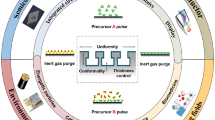Abstract
Low-pressure imprint is interesting to avoid stamp deformation, stamp failure as well as polymer recovery. When large-area stamps are prepared with a stepping procedure, low pressure is required to optimize the stitching. However, with low-pressure imprint, conformal contact between stamp and substrate is critical. Admittedly, the imprint pressure required for conformal contact depends on the stamp material and its thickness. To get an idea to which extent the imprint pressure can be reduced with a flexible stamp, we compared different stamp materials and stamp architectures, single-layer stamps and two-layer stamps. The two-layer stamps are replica stamps, where the structures were replicated in a thin layer of OrmoStamp, fixed by a backplane. On the background of plate theory, we deduce the pressure reduction compared to a Si stamp by calculating the respective pressure ratio, independent from geometries. In addition, temperature-induced issues are addressed which are of relevance for a thermal imprint process. These issues are related to the mismatch between the thermal expansion coefficients of the stamp and the substrate, and in case of a two-layer stamp, to the mismatch between the backplane material and the top layer. The latter results in temperature-induced stamp bending. On the basis of simple analytical calculations, the potential of single-layer stamps and two-layer stamps with respect to thermal imprint at reduced pressure is discussed and guidelines are provided to assess the imprint situation when replica stamps are used for imprint. The results demonstrate the attractiveness of two-layer stamps for reduced pressure nanoimprint, even in a temperature-based process.





Similar content being viewed by others
References
H. Schift et al., Nanotechnology B12, 173 (2001)
R. Yang et al., Microelectron. Eng. B86, 1379 (2009)
B. Cui, T. Veres, Microelectron. Eng. B83, 902 (2006)
A. Lebib et al., Microelectron. Eng. B46, 319 (1999)
H.-C. Scheer et al., J. Vac. Sci. Technol. B27, 2882 (2009)
H.W. Ro et al., J. Vac. Sci. Technol. B24, 2973 (2006)
M. Papenheim et al., J. Vac. Sci. Technol. B32, 2166 (2014)
W.M. Choi, O.O. Park, Nanotechnology B15, 1767 (2004)
K.Y. Suh et al., Adv. Mater. B13, 1386 (2001)
R. Kirchner, On UV-nanoimprint-lithography as direct patterning tool for polymeric microsystems (Ph.D thesis), University Dresden 2011
B. Michel et al., IBM J. Res. Dev. B45, 697 (2001)
S.-Y. Hwang, Microelectron. Eng. B86, 642 (2009)
T. Mäkelä et al., Jpn. J. Appl Phys B47, 5142 (2008)
L. Montelius et al., Microelectron. Eng. B53, 521 (2000)
A. Schleunitz et al., Microelectron. Eng. B88, 2113 (2011)
M.R. Sonne, J.H. Hattel, Microelectron. Eng. B106, 1 (2013)
L. D. Landau, E. M. Lifschitz, Elastizitätstheorie, Bd. 7 (Akademie Verlag, 1991)
J.A. Dally, W.F. Riley, Experimental Stress Analysis (McGrawHill, 1991)
S. Timoshenko, S. Woinowsky-Krieger, Theory of Plates and Shells (McGrawHill, 1987)
D. Gross, T. Seelig, Bruchmechanik, Bd.7 (Springer, 2007)
M. Ohring, The Materials Science of Thin Films (Academic Press, 1991)
S. Landis et al., Microelectron. Eng. B110, 198 (2013)
Acknowledgments
Partial funding by Deutsche Forschungsgesellschaft DFG is highly acknowledged.
Author information
Authors and Affiliations
Corresponding author
Rights and permissions
About this article
Cite this article
Papenheim, M., Dhima, K., Wang, S. et al. Single-layer versus two-layer stamps for reduced pressure thermal nanoimprint. Appl. Phys. A 121, 481–487 (2015). https://doi.org/10.1007/s00339-015-9301-2
Received:
Accepted:
Published:
Issue Date:
DOI: https://doi.org/10.1007/s00339-015-9301-2




